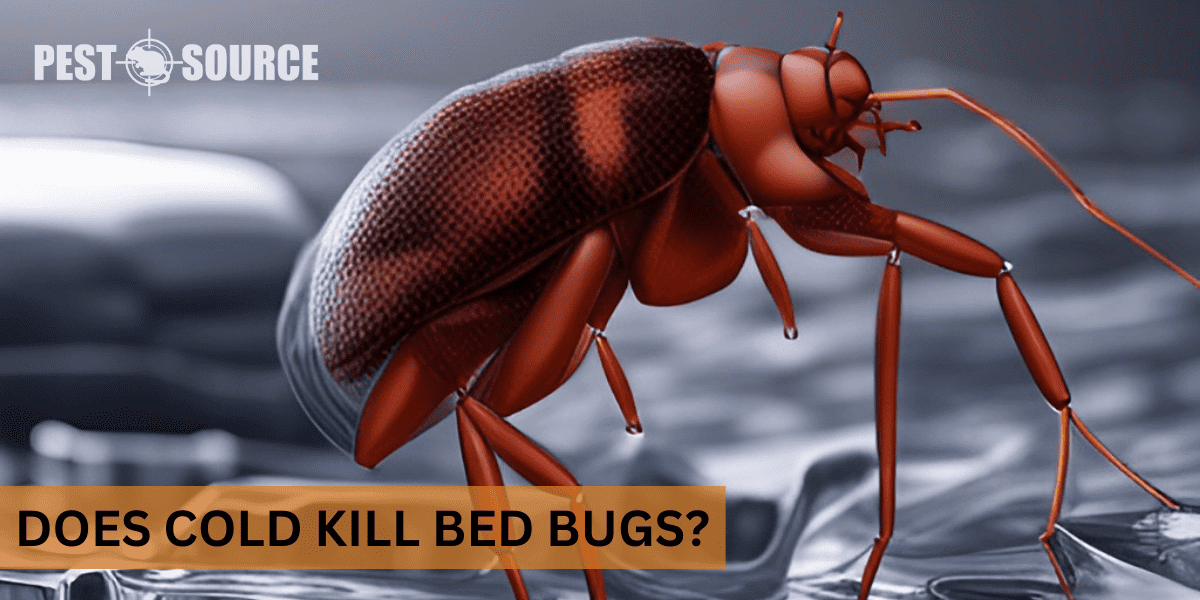Exposure to extreme cold can kill bed bugs, but it requires sustained temperatures below 0°F (-18°C) for at least four days. This method’s effectiveness varies based on the duration of exposure and the bugs’ life stages. This post will explore the practicality of using cold treatment against bed bugs, including its limitations and how it compares to other eradication methods.
POINTS
- Cold can effectively kill bed bugs at all stages of their lifecycle if they are exposed to temperatures at or below 0°F (-18°C) for a consistent period. This makes cold treatment a non-toxic and environmentally friendly method for eliminating bed bugs.
- The effectiveness of cold treatment is contingent upon multiple factors, including the infestation’s size, the location of the bugs, the duration of exposure, and the bed bug strain’s potential resistance to cold. In some cases, prolonged exposure to low temperatures might not completely eradicate a bed bug infestation.
- Larger infestations or those in hard-to-reach areas might require a more integrated pest management approach combining cold with other treatments such as chemical pesticides or heat treatment.
- Items that are infested with bed bugs, like clothing, luggage, or furniture, can effectively undergo cold treatment by being sealed in a bag and placed in a deep freezer set at 0°F or lower for at least four days.
- It is highly recommended to consult with a pest control professional when considering cold treatment for bed bugs. A professional can accurately identify the extent of an infestation, recommend the most effective treatment plan, and ensure the safe application of various treatment methods.
Cold and Bed Bug Eradication
Bed bugs are they resilient pests that have been terrorizing homes for centuries. Although they are small in size, they can create big problems. Bed bugs are ectotherms, meaning they cannot regulate their own body temperature but depend on the surrounding environment to maintain their temperature. So, does this natural reliance on external temperature make them particularly vulnerable to cold treatments?
How does cold impact bed bugs?
To put it simply, cold can indeed be lethal to bed bugs. Low temperatures can cause their bodily functions to slow down, eventually leading to their death. However, exposing bed bugs to just your average winter chill won’t do the trick; you need to expose them to temperatures that are exceptionally low and for a prolonged period to assure death.
What are bed bugs and how are they affected by temperature changes?
Bed bugs (Cimex lectularius) are small, oval insects that feed on the blood of humans and other warm-blooded animals. They’re nocturnal pests that can give bites, leading to skin irritation and allergic reactions. As for their temperature preference, bed bugs thrive in a habitat that sits at room temperature around 70°F to 80°F.
Exposure to temperatures below or above their comfortable thermal range can cause physiological strain, leading to mortality if the temperature is extreme enough. Yet, bed bugs have demonstrated a degree of resilience to both heat and cold, so the exposing temperature has to be drastic and the exposure time long. But how exactly does this process work? Let’s look at the mechanism next.
Mechanism of Cold Treatment: What Happens When Bed Bugs are Exposed to Cold?
Understanding the cold treatment process will help you appreciate its effectiveness and perhaps also its limitations.
How do bed bugs die naturally when exposed to cold?
Cold acts as a slow-acting poison on bed bugs. When exposed to exceptionally low temperatures, the bed bug’s physiological activities begin to slow down. Their movement becomes sluggish, feeding is affected, and reproductive activities may halt. If the cold exposure is maintained, ultimately, these pests die.
What happens to bed bugs at varying degrees of cold temperatures?
The colder the temperature, the quicker bed bugs die. At slightly lower temperatures than they’re accustomed to, bed bugs go into a hibernation-like state, effectively slowing their metabolism and reproduction. However, when the exposure temperature drops to freezing or below, they face the risk of freezing to death, especially if this temperature is maintained for enough time.
Does cold weather automatically kill bed bugs, or is a specific cold treatment necessary?
Don’t assume that winter weather can handle your bed bug problem. The typical winter chill isn’t usually enough to kill bed bugs, as these pests have adapted to survive in cold environments by going into a pseudo-hibernation state, effectively reducing their activity until warmer temperatures return. So, if you’re looking to use cold as a weapon against bed bugs, you’ll need to conduct a specific cold treatment. This process exposes these pests to temperatures far lower than those of your average winter, and for enough time to ensure they succumb.
Understanding the Lethal Cold Temperature for Bed Bugs
If you’re considering using cold to treat a bed bug infestation, knowledge about the lethal temperatures for these pests is essential.
What temperature kills bed bugs?
Research suggests that bed bugs can die under sustained exposure to temperatures at or below 0°F (-18°C). However, the duration of exposure plays a critical role in ensuring all bed bugs, including eggs, are eradicated.
At what temperature do bed bugs die instantly?
There’s no exact temperature that kills bed bugs instantly. Even when exposed to a deep freezer’s temperature, bed bugs need time to succumb to the cold. However, it’s noticed that temperatures of -20°F (-29°C) and lower have a more immediate impact but still require several days of exposure.
What temperature kills bed bugs and their eggs?
Bed bug eggs can tolerate slightly lower temperatures than adult bed bugs. To kill eggs, you have to expose them to a temperature of -20°F (-29°C) consistently for days.
How does this lethal temperature vary depending on the stage of development of the bed bug?
Younger bed bugs, also known as nymphs, and eggs are more resistant to cold treatments as compared to adult bed bugs. Adult bed bugs may succumb to lower temperatures within a few days, while eggs, being more insulated, require an extended period of exposure for complete eradication.
The Practicalities of Cold Treatment
Now that you understand how cold affects bed bugs, let’s explore the practical applications of cold treatment.
What are the different methods of applying cold to kill bed bugs?
There are two primary methods for cold treatment:
- Freezer Method: This involves placing infested items in a freezer set at 0°F or lower.
- Dry Ice Method: Here, infested items are placed in a container with dry ice. The emitted cold and carbon dioxide work together to effectively kill bed bugs.
How effective is freezing for killing bed bugs?
Freezing has been shown to be effective in eradicating bed bugs. However, the effectiveness depends on several factors, including the temperature of the freezer, the duration of exposure, and the life stage of the bed bugs.
Can you kill bed bugs in a freezer and how long does it take?
Yes, freezing is a viable method for killing bed bugs. But remember, bed bugs need to be exposed to freezing temperatures for an extended period. Typically, keeping infested items at a steady 0°F for about four days can successfully kill bed bugs at all stages.
Can you freeze bed bugs by placing infested items in a freezer, and how effective is this method?
Freezing infested items can be highly effective in eliminating bed bugs, especially if it’s possible to keep those items in the freezer for multiple days. It’s a method most suitable for smaller items like clothing, bedding, and books.
How do you kill bed bugs in a freezer: what specific steps should be followed?
To properly freeze bed bugs, follow these steps:
- Place infested items in a bag to avoid spreading the infestation.
- Set your freezer to 0°F or below.
- Put the bagged items in the freezer and leave them for at least four days to ensure all bugs are killed.
- After treatment, let the items slowly get back to room temperature to avoid condensation and potential damage.
What is the role of dry ice in cold treatment of bed bugs?
Dry ice can be effective in killing bed bugs due to its exceptionally low temperature. Bed bugs are also attracted to carbon dioxide emitted by dry ice, making it more effective. It’s important to use this method with caution, though, as dry ice can be hazardous if improperly handled.
Efficacy of Cold Treatment: Does Cold Treatment Always Kill Bed Bugs?
Now that we’ve addressed the methods to apply cold to kill bed bugs, let’s turn our attention to its effectiveness.
Does freezing kill bed bugs in all stages of their development, including eggs?
Yes. Sustained freezing temperatures can effectively eradicate bed bugs at all stages of their development – from eggs to adults. However, different stages may require different durations of exposure, with eggs usually needing more time to be effectively killed.
Can the cold kill bed bugs in any infested area, or are there limitations?
While cold has the power to kill bed bugs, there are limitations to where it can be used. Small, sealed spaces and individual items can be effectively treated with cold. However, large areas or entire rooms are challenging to treat as they are difficult to lower to the required temperatures and maintain consistently.
Does freezing temperatures always kill bed bugs, or are there resistant strains?
Most bed bugs are susceptible to freezing temperatures with enough exposure time. However, recent studies indicate some strains of bed bugs might show resistance to cold, as well as heat and chemical treatments. Therefore, a well-rounded approach including physical, chemical, and temperature treatments may provide the best results.
Limitations and Challenges of Cold Treatment
While cold treatment can be a valuable tool in your pest control arsenal, there are some challenges to consider.
What are the challenges associated with using cold treatment for bed bugs?
Maintaining the freezing temperatures long enough to penetrate hiding spots and ensure complete eradication of bed bugs, especially eggs, is the major challenge of cold treatment. Disruptive bugs may move in response to cold, escaping treated areas. Furthermore, the infestation’s size and location can limit cold treatment’s practicality.
Why might cold treatment not be suitable for all infested areas?
Cold treatment is not always practical for treating large areas, difficult-to-reach spaces or electronic equipment. These situations may need alternative treatments, and also note that insulation in modern homes can interfere with achieving and maintaining lethal temperatures.
What are some limitations and precautions when using freezing temperatures to kill bed bugs?
To avoid damage to non-resistant materials and ensure safety, choose what to freeze carefully, especially when considering electronics or delicate items. Don’t forget that cold treatment may not reach all bugs, as some could move away to warmer spots. Also, remember that some bed bugs might have cold resistance, reducing the treatment’s effectiveness.
Complementing Cold Treatment with Other Methods
Cold treatment as a standalone method works efficiently, but sometimes it may need to be combined with other approaches for total eradication.
When and why might it be necessary to combine cold treatment with other methods of bed bug control?
Cold treatment might not kill all bugs in large infestations due to the cold-resistant bed bugs, unreachable hiding spots, and challenges in maintaining low temperatures. In such scenarios, heat treatment or chemical pesticides can be integrated into the pest management plan to ensure comprehensive bed bug control.
How can heat treatment or chemical treatment complement cold treatment?
Heat treatment for bed bugs can penetrate areas cold might not reach effectively and is an excellent option for large spaces and heavily infested areas. Chemical treatment, on the other hand, can persist in the environment for a duration, providing a long-term lethal condition for any bugs escaping the initial treatment. Using these methods together can heighten the chances of complete eradication.
Professional Intervention: When Should You Consult a Pest Control Professional for Cold Treatment?
While cold treatment can be an effective weapon in the war on bed bugs, certain situations may require the expertise of pest control professionals.
How effective is cold as a standalone method for controlling bed bugs?
Cold is a powerful tool against bed bugs when applied correctly. It can eradicate bed bugs at all life stages without the use of chemicals, making it environmentally friendly. However, its effectiveness can depend on various factors like the extent of the infestation and the duration of exposure.
What are the primary benefits and limitations of using cold to kill bed bugs?
Benefits include its non-toxicity, the ability to kill all stages of bed bugs, and the lack of chemical resistance. However, its use is limited by factors such as infestation size, location, temperature required, and exposure duration. It could also be less effective against cold-tolerant strains.
In what circumstances should cold be considered as a method for killing bed bugs?
Cold treatment is ideal for small-scale infestations where bed bugs have infested specific items that can be isolated and treated separately. These can be clothing, luggage, devices, or pieces of furniture. If the infestation is widespread or in hard-to-reach places, cold treatment might need to be just part of a multi-pronged attack.
When is it necessary to combine cold treatment with other methods of bed bug control, and why?
When dealing with large infestations, especially in hard-to-reach areas, or when facing cold-tolerant strains, you might need to supplement cold treatment with other methods such as heat treatment or pesticides. An integrated approach can ensure a more comprehensive eradication effort.
Why is it important to consult with a pest control professional when considering cold treatment for bed bugs?
A pest control professional has the experience and knowledge to accurately assess the extent of an infestation and suggest the most effective combination of treatments. They also know how to safely apply treatments like cold or chemical methods, ensuring your home is pest-free while minimizing any risk to you or your family.
How can a pest control professional help you determine if cold treatment is the right option and ensure it is safe and effective?
A professional can judge the most effective treatment based on the infestation’s scale, location, and the specific strain of bed bugs in your home. They’ll monitor the treatment to ensure it’s working and adjust the strategy if necessary. Their experience can prove invaluable in completely removing these persistent pests from your home.



